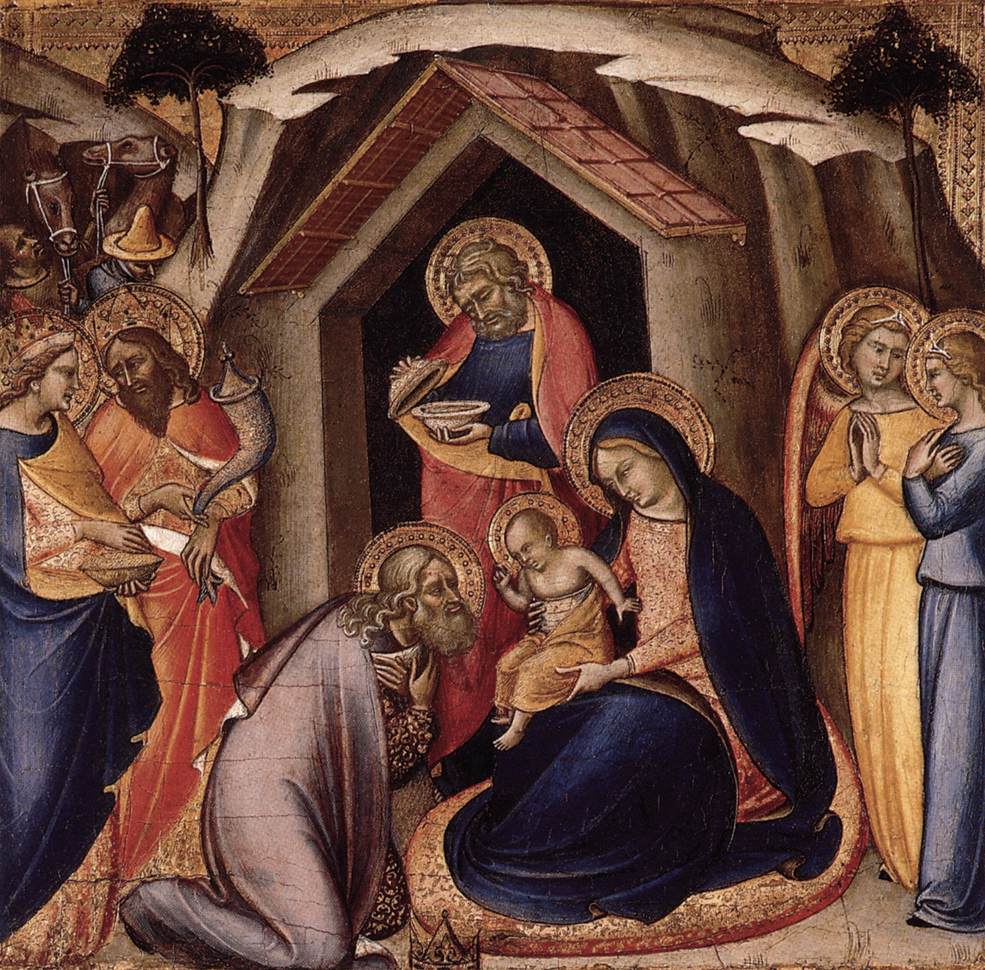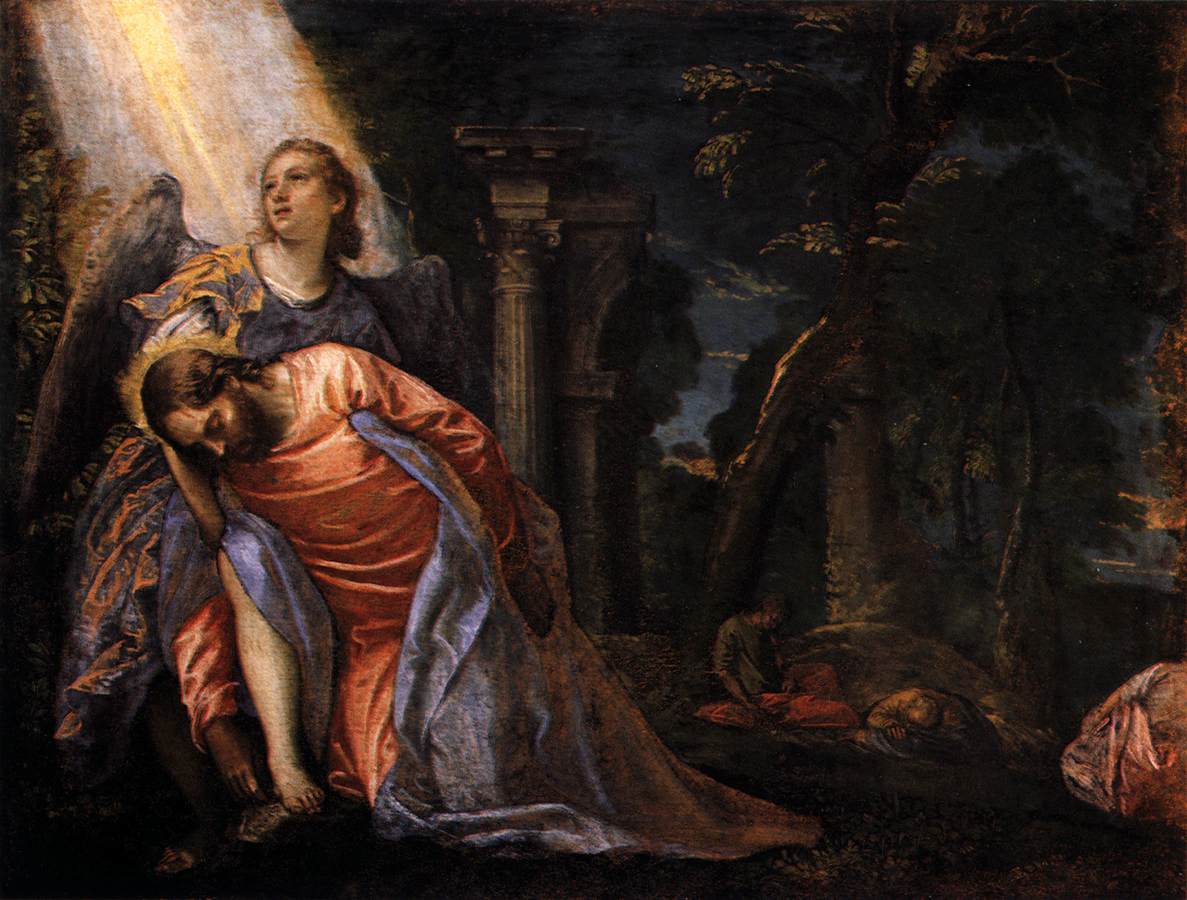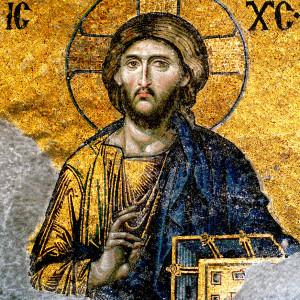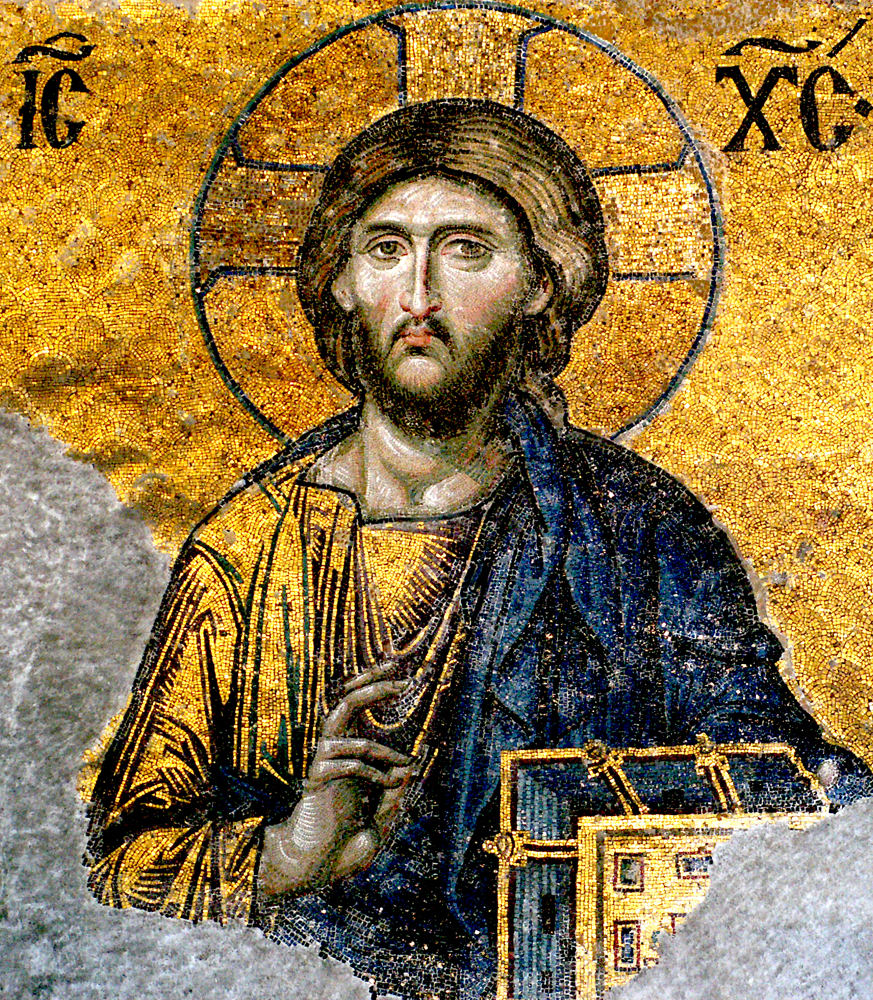If Jesus Christ is both fully human and fully God, was He human before the Incarnation?
If He wasn’t, why would the Nestorian position be heretical, since Christ is fully divine and His humanity was only a later addition?
And if He was, would that mean that humanity, as it existed in the form of Christ, has been there from the beginning of time?
The short answer is that Jesus was not human before the Incarnation, and that Nestorianism is wrong for rejecting the Hypostatic Union. So let’s address the Catholic position, and then compare it with the early heresies.
 |
| Luca Di Tommè, Adoration of the Magi (c. 1365) |
Yesterday, the Antiphon for Lauds put it like this:
Marvelous is the mystery proclaimed today: man’s nature is made new as God becomes man; he remains what he was and becomes what he was not. Yet each nature stays distinct and for ever undivided.
That’s the Hypostatic Union in a nutshell. The Second Person of the Trinity, the Divine Logos, was (and is) God from all eternity. In the Incarnation, He entered space and time as Jesus of Nazareth. While preserving His Divinity whole and intact, He humbled Himself by taking on our humanity. This meant creating a human body and also a human soul for Himself. Jesus wasn’t simply a mask the Logos wore, or an avatar, or anything of the sort. Rather, the Man Jesus is the Second Person of the Trinity, and vice versa. The Second Person of the Trinity united His human soul perfectly to His Divine Self. In doing so, He bridged the gulf created by sin between God and man. This is one of the reasons that we refer to Jesus by the titles “Son of Man” and “Son of God” without any tension: He’s the perfect God-Man (see Matthew 26:63-64, in which the two titles are used interchangably).
Compare what Catholicism teaches on Christology, compared with two popular fifth century heresies, Nestorianism and Monophysitism:
| Catholicism | Two Natures | One Person |
| Nestorianism | Two Natures | Two Persons |
| Monophysitism | One Nature | One Person |
There were the more moderate versions of two other heresies: Docetism, which said that Jesus only appeared to be human, and its antithesis, Adoptionism, which said Jesus was only a man prior to His Baptism.
Nestorianism and Monophysitism were both half-right, but the parts they got wrong were incredibly problematic. Nestorianism acknowledged that Christ had both human and Divine natures, but claimed that these natures weren’t united in a single Person. Instead, Christ was a Being consisting of a human person and a Divine Person. In other words, this view taught that Jesus, the Man, wasn’t the Second Person of the Trinity. As a result, Nestorius refused to call Mary Theotokos (God-bearer), calling her instead Christotokos (Christ-bearer). Thus, we see many of the same problems as in Adoptionism — that Jesus isn’t to be the object of our worship. But since Jesus is worshiped in Scripture (John 20:28), this view is clearly wrong.
 |
| Paolo Veronese, Christ in the Garden of Gethsemane (1584) |
Just as Nestorianism is a moderate (but still incorrect) form of Adoptionism, Monophysitism is a moderate (but still incorrect) form of Docetism. Monophysitism recognized that Jesus is the Second Person of the Trinity, but as a result, denied that He had both a human and Divine will. But we see Christ subordinate His human will to the Father (John 14:28; Luke 22:42), so this is clearly wrong, too.
Here’s the thing about the Hypostatic Union: like the Trinity, it seems needlessly complex; like the Trinity, it’s a pretty counter-intuitive theological claim; but like the Trinity, it explains the Scriptural evidence better than all of the (much simpler) heresies. Sometimes, the truth is just more complicated than fiction, and we shouldn’t be surprised that describing God is one of those times, whether we’re talking about the Three Persons of the Trinity, or the Dual Natures of Christ.
Nestorianism was condemned at the First Council of Ephesus in 431, while both Nestorianism and Monophysitism were condemned at the Council of Chalcedon in 451. A few men stand out as strong defenders of the faith in the face of Nestorianism and Monophysitism. One of those was Pope Leo. From Session V of the Council of Chalcedon:
The most blessed bishops of Illyria said: Let those who contradict be made manifest. Those who contradict are Nestorians. Those who contradict, let them go to Rome.
The most magnificent and most glorious judges said: Dioscorus acknowledged that he accepted the expression of two natures, but not that there were two natures. But the most holy archbishop Leo says that there are two natures in Christ unchangeably, inseparably, unconfusedly united in the one only-begotten Son our Saviour. Which would you follow, the most holy Leo or Dioscorus?
The most reverend bishops cried out: We believe as Leo. Those who contradict are Eutychians. Leo has rightly expounded the faith.
The most magnificent and glorious judges said: Add then to the definition, according to the judgment of our most holy father Leo, that there are two natures in Christ united unchangeably, inseparably, unconfusedly.
Leo stood in a long line of saintly defenders of orthodoxy. A century earlier, the battle had been on somewhat different turf: whether Jesus was God, or simply God-like. Catholicism was defended in that earlier fight by St. Athanasius, as well as two Saints whose Feast Day we celebrate today: St. Basil the Great and St. Gregory Nazianzen.
Let this be a reminder that orthodox Catholicism has always been attacked, often by pretty convincing sounding heresies (both Nestorianism and Monophysitism could marshal Scriptural support, for example). But it’s important to remember that Catholicism always wins out in the end. Today, even those churches that have been historically Nestorian (the Assyrian Church of the East) or Monophysite (the Oriental Orthodox Churches) have distanced themselves from their Non-Chalcedonian origins. History should thus lead us to be both vigilant and hopeful.



I appreciate your thoughts on the incarnation. I agree with your Christology. You make a great point by connecting mystery of the incarnation to the trinity. Both go against common sense, and both require faith. Great post!
This is the most important statement:
“Nestorianism acknowledged that Christ had both human and Divine natures, but claimed that these natures weren’t united in a single Person. Instead, Christ was a Being consisting of a human person and a Divine Person.”
It is good that you said this because a common is to forget there is not only a Person-Nature distinction, but that there is a human-person and Divine-Person distinction as well. Jesus was and always will be a single Divine Person. Not realizing this, or not being careful enough, some people actually incorrectly say a single person *resulted* from the Union, as if a human/divine person hybrid also resulted, but that’s just as heretical.
The Westminster Confession of Faith actually makes this very error:
“II. The Son of God, the second person of the Trinity, being very and eternal God, of one substance and equal with the Father, did, when the fullness of time was come, take upon Him man’s nature,[10] with all the essential properties, and common infirmities thereof, yet without sin;[11] being conceived by the power of the Holy Ghost, in the womb of the virgin Mary, of her substance.[12] So that two whole, perfect, and distinct natures, the Godhead and the manhood, were inseparably joined together in one person, without conversion, composition, or confusion.[13] Which person is very God, and very man, yet one Christ, the only Mediator between God and man.[14]”
The Westminster can be said to be conflating a human and divine personhood, resulting in a hybrid personhood!!!
2000 years ago people had no problem believing that Jesus was God, it was whether or not Jesus was also a man that go them into trouble. Today, it’s the opposite in academic circles: Secular Biblical scholars have no problem believing that Jesus was a flesh and blood man, its the whole claiming to be God that’s hard for them to accept.
Along similar lines of Christ’s nature, I’ve sometimes had a thought-experiment whereby Jesus Christ is plucked out of his home in 1st century Israel, and put into a modern 21st century hospital. I wonder what modern doctors would conclude about him.
Most likely they would say (which goes back to the substance vs accidents found also in the explanation of the Eucharist) that this is a male human being, who has never had access to modern medicine, or dentistry, and that he has worked outside in the hot sun for hours at a time as a manual laborer for almost his entire life lifting heavy rocks and slabs of wood. AKA, a guy you don’t want to meet in a dark alley at 3 o’clock in the morning.
Which gives new meaning to Jesus’ kicking the money-changers out of the temple. Imagine an average Hells Angel fresh out of prison fighting a group of accountants and tax attorneys.
Wouldn’t mormonism fall into one and or both of these heresies since they believe that “heavenly father” was man and achieved godhood? Or is mormonism a different heresy in itself??
Patrick,
Mormonism has some more fundamental problems. Nestorianism and Monophysitism are both compatible with Trinitarianism: they’re Christological heresies, not Trinitarian heresies. But Mormonism has a skewed view of both the Trinity and the natures of Christ.
I.X.,
Joe
Joe,
How exactly Catholicism triumphed over Protestantism and its subsequent modern currents? In this post-modern era that gives us nothing but anti-catholicism, sometimes it’s hard to grasp the whole picture of the Church’s glory and triumph.
If people all acknowledge that Jesus is both human and divine, what’s the point of arguing and dividing over interpretations of the mechanics of how exactly that works? Its just silly.
And it doesn’t seem accurate to me to say Nestorianism has Christ as two persons. Nestorius just simply objected to calling Mary ‘mother of God’ and said the term ‘mother of Christ’ should be used instead — not because he didn’t believe Christ was God while in the womb, but because he though the phrase had Pagan undertones, and further because (I think) of Hebrews 7’s statement that Christ was made like Melichizedek (or Melchizedek was made like Christ) “having neither mother or father.” Thus, Nestorianism says: Christ as man has no father — Christ as God has no mother. That is not making two persons out of Christ, but explaining the meaning of the phraseology in Hebrews 7. If anything should be considered heresy then, it is the demonization of Nestorianism.
The Fourth Lateran Council teaches that God is a “substantia seu natura simplex omnino”—an “altogether simple substance or nature”—and the First Vatican Council reiterated the teaching. But Christ, as man, is clearly not immutable or simple. Thus it seems that Divine Simplicity refers to the simplicity of the Divine Nature, not the Divine Persons. Is that how you resolve the apparent contradiction”?